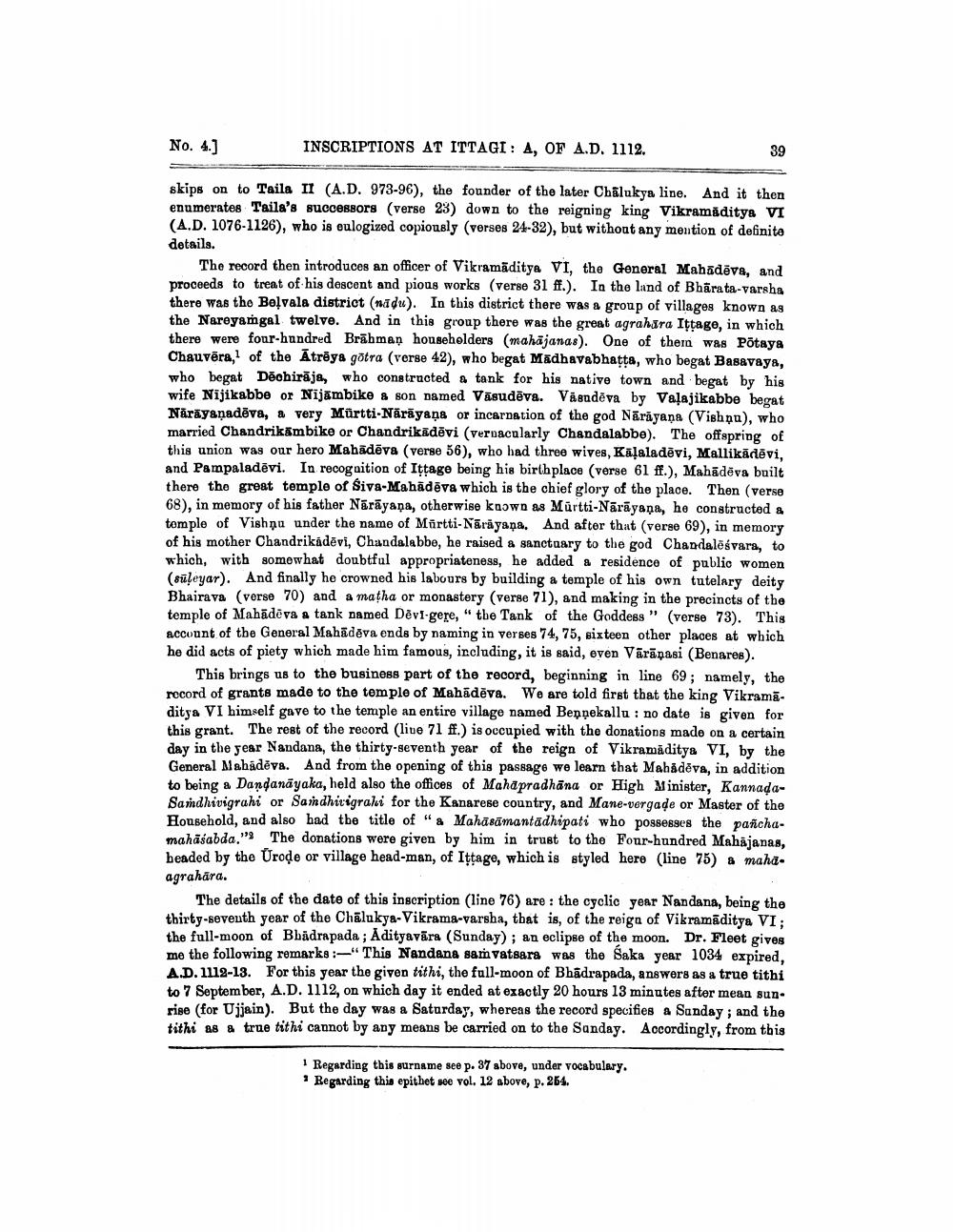________________
No. 4.]
INSCRIPTIONS AT ITTAGI: A, OF A.D. 1112.
skips on to Taila II (A.D. 973-96), the founder of the later Chilukya line. And it then enumerates Taila's successors (verse 23) down to the reigning king Vikramiditya VI (A.D. 1076-1126), who is eulogized copiously (verses 24-32), but without any mention of definite details.
The record then introduces an officer of Vikramāditya VI, the General Mahadeva, and proceeds to treat of his descent and pions works (verse 31 ff.). In the land of Bhärata-varsha there was tho Beļvala district (nadu). In this district there was a group of villages known as the Nareyamgal twelve. And in this group there was the great agrahara Ittage, in which there were four-hundred Brāhman householders (mahajanas). One of them was Potaya Chauvēra, of the Ātrêya götra (verse 42), who begat Madhavabhatta, who begat Basavaya, who begat Dēohirāja, who constructed & tank for his native town and begat by his wife Nijikabbe or Nijambike & son named Vāsudēva. Våendēva by Valajikabbe begat Nārāyaṇadēva, a very Mürtti-Nārāyang or incarnation of the god Nārāyana (Vishnu), who married Chandrikambike or Chandrikādēvi (vernacularly Chandalabbe). The offspring of this union was our hero Mahādēva (verse 56), who had three wives, Kāļaladēvi, Mallikādēvi, and Pampaladevi. In recognition of Ittage being his birthplace (verse 61 ff.), Mahadeva built there the great temple of Siva-Mahādēva which is the chief glory of the place. Then (verse 68), in memory of his father Nārāyaṇa, otherwise known as Mürtti-Nārāyaṇa, he constructed & temple of Vishnu under the name of Mürtti-Nārāyaṇa. And after that (verse 69), in memory of his mother Chandrikādēvi, Chandalabbe, he raised a sanctuary to the god Chandaleśvara, to which, with somewhat doubtful appropriateness, he added a residence of public women
süleyar). And finally he crowned his labours by building a temple of his own tutelary deity Bhairava (verse 70) and a matha or monastery (verse 71), and making in the precincts of the temple of Mahadeva a tank named Devi.gere, "the Tank of the Goddess" (verse 73). This account of the General Mahādēva ends by naming in verses 74, 75, sixteen other places at which he did acts of piety which made him famous, including, it is said, even Vārāṇasi (Benares).
This brings us to the business part of the record, beginning in line 69; namely, the record of grants made to the temple of Mahādēva. We are told first that the king Vikramā. ditya VI himself gave to the temple an entire village named Benpekalla : no date is given for this grant. The rest of the record (live 71 ff.) is occupied with the donations made on a certain day in the year Nandana, the thirty-seventh year of the reign of Vikramaditya VI, by the General Mahadeve. And from the opening of this passage we learn that Mahädēva, in addition to being a Dandanayaka, held also the offices of Mahapradhāna or High Minister, KannadaSamdhivigrahi or Sandhitigrahi for the Kanarese country, and Mane-vergade or Master of the Household, and also had the title of "& Mahāsāmantadhipati who possesses the panchamahasabda," The donations were given by him in trust to the Four-hundred Mahajanas, beaded by the Urode or village head-man, of Ittage, which is styled here (line 75) & maha. agrahāra.
The details of the date of this inscription (line 76) are : the cyclic year Nandana, being the thirty-seventh year of the Chalukya-Vikrama-varsha, that is, of the reiga of Vikramaditya VI; the full-moon of Bhadrapada ; Adityavāra (Sunday); an eclipse of the moon. Dr. Fleet gives me the following remarks :-"This Nandana samvatsara was the Saka year 1034 expired, A.D. 1112-13. For this year the given tithi, the full-moon of Bhadrapada, answers as a true tithi to 7 September, A.D. 1112, on which day it ended at exactly 20 hours 13 minutes after mean sun. rise (for Ujjain). But the day was a Saturday, whereas the record specifies a Sanday; and the tithi as a true tithi cannot by any means be carried on to the Sunday. Accordingly, from this
Regarding this surname see p. 37 above, under vocabulary. . Regarding this epithet see vol. 12 above, p. 264.




